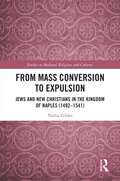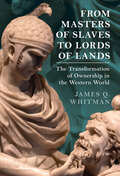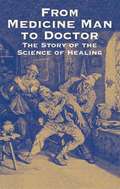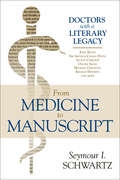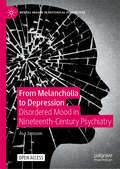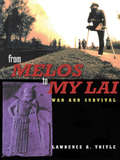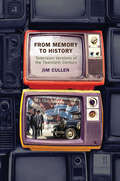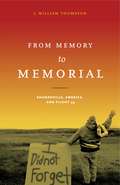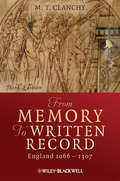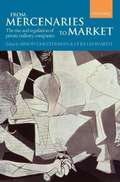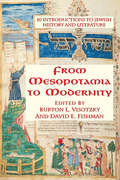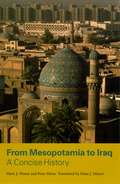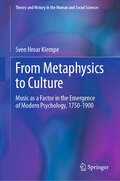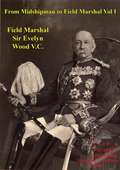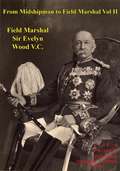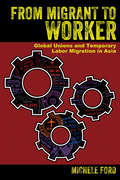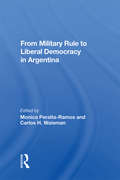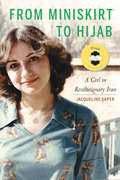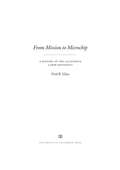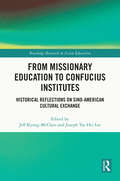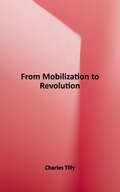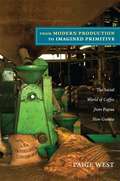- Table View
- List View
From Mass Conversion to Expulsion: Jews and New Christians in the Kingdom of Naples (1492–1541) (Studies in Medieval Religions and Cultures)
by Nadia ZeldesThis book explores the events that marked the last decades of Jewish presence in the kingdom of Naples from 1492 to 1541. It employs a comparative approach in the examination of the mass conversion of the Jews in the Kingdom of Naples in 1495, the failed attempt to establish a Spanish‑style inquisition, and the expulsions of 1510 and 1541. By relying on a variety of sources, including Hebrew literary works and rabbinic Responsa, this study sheds new light on the reception of the refugees of 1492, the evolvement of the political and military crisis of 1495, the attacks on the Jewish communities, and Jewish reaction, all aspects that have never before been subject to systematic analysis. The Spanish victory of 1503 and the transformation of southern Italy into a Spanish‑ruled dominion bring this discussion closer to the Iberian model of mass conversions and expulsions. The unprecedented expulsion of the New Christians along with the Jews offers a unique opportunity for drawing a parallel with the much later expulsion of the Moriscos from Spain.By highlighting these aspects, this book offers insights for understanding the larger issues of the integration of refugees and rejection of minority groups, questions that are as relevant to present concerns and politics as they were on the eve of the modern era.
From Masters of Slaves to Lords of Lands: The Transformation of Ownership in the Western World (Studies in Legal History)
by James Q. WhitmanToday we think of land as the paradigmatic example of property, while in the past, the paradigmatic example was often a slave. In this seminal work, James Q. Whitman asserts that there is no natural form of ownership. Whitman dives deep into the long Western history of this transformation in the legal imagination – the transformation from the ownership of humans and other living creatures to the ownership of land. This change extended over many centuries, coming to fruition only on the threshold of the modern era. It brought with it profound changes, not only in the way we understand ownership but also in the way we understand the state. Its most dramatic consequence arrived in the nineteenth century, with the final disappearance of the lawful private ownership of humans, which had been taken for granted for thousands of years.
From Medicine Man to Doctor: The Story of the Science of Healing
by Howard W. HaggardCompelling and informative, this overview of medical history traces modern-day medical practices from their roots in the ancient civilizations of Egypt, Greece, and Rome. Physician Howard W. Haggard — a popular lecturer, prolific author, and Yale professor — specialized in explaining health-related issues to ordinary people. This 1929 survey offers fascinating facts and anecdotes from around the world in its chronicles of the development of obstetrical methods, anesthesia, surgery, drugs, and other landmarks in the science of healing.The first chapters examine the treatment of child-bearing women throughout the centuries, from practices related to the legends of Aesculapius and Hygeia to the long battle against puerperal fever, the invention of obstetrical forceps, and the rise of anesthesia. A profile of the progress of surgery explores the violent opposition to early attempts at studying anatomy through human dissection, and the gradual adoption of antiseptic principles. Quarantine, vaccination, and a heightened public awareness are cited among the record of attempts to conquer plague and pestilence.Final chapters investigate faith healing through the ages and occult practices such as exorcism and the trade in holy relics; herb doctors and medieval apothecaries; the recognition of bacteria as a cause of infectious disease; and the eventual trend away from treatment and toward prevention.
From Medicine to Manuscript: Doctors with a Literary Legacy
by Seymour I. SchwartzAn eminent surgeon, who has written books on the history of medicine and cartography, profiles physicians past and present who have also published works in the humanities.Throughout history doctors have felt the need to express themselves in prose and poetry, often on subjects far removed from their medical interests. Renowned surgeon Seymour I. Schwartz felt this same compulsion to write and eventually decided to investigate other authors with a background in medicine. The result is this informative and entertaining compilation of biographical profiles spanning the Middle Ages to the present era.In many cases, literary fame has eclipsed memory of these authors' medical expertise: Most people today talk about Maimonides, Rabelais, Locke, Schiller, Keats, Conan Doyle, and Chekhov because of their literary works, not because they practiced medicine. But the lesser-known individuals are just as interesting in many ways: such people as Cadwallader Colden, the loyalist lieutenant governor of New York during the American Revolution, who wrote the first English history of the Iroquois; Margaret Georgina Todd, author of popular novels in the Victorian era, which promoted the idea of women in medicine; and Rudolph John Chauncey Fisher, who was not only a physician, researcher, and radiologist, but played a role in the Harlem Renaissance as an orator, musician, musical arranger, and literary figure.Concluding with profiles of contemporary doctors who are also respected authors, this diverse collection shows that, despite increasing specialization, medicine and the humanities continue to complement each other to enrich our lives.
From Melancholia to Depression: Disordered Mood in Nineteenth-Century Psychiatry (Mental Health in Historical Perspective)
by Åsa JanssonThis open access book maps a crucial but neglected chapter in the history of psychiatry: how was melancholia transformed in the nineteenth century from traditional melancholy madness into a modern biomedical mood disorder, paving the way for the emergence of clinical depression as a psychiatric illness in the twentieth century? At a time when the prevalence of mood disorders and antidepressant consumption are at an all-time high, the need for a comprehensive historical understanding of how modern depressive illness came into being has never been more urgent. This book addresses a significant gap in existing scholarly literature on melancholia, depression, and mood disorders by offering a contextualised and critical perspective on the history of melancholia in the first decades of psychiatry, from the 1830s until the turn of the twentieth century.
From Melos to My Lai: A Study in Violence, Culture and Social Survival
by Lawrence A. TritleFrom Melos to My Lai presents an erudite, provocative and moving analysis of the accounts of violence in the literature and history of ancient Greece and in the film literature and veterans' accounts of the Vietnam War. This comparative investigation examines the nature of violence, its impact on society and culture, especially as reflected from th
From Memory to History: Television Versions of the Twentieth Century
by Jim CullenOur understanding of history is often mediated by popular culture, and television series set in the past have provided some of our most indelible images of previous times. Yet such historical television programs always reveal just as much about the era in which they are produced as the era in which they are set; there are few more quintessentially late-90s shows than That ‘70s Show, for example. From Memory to History takes readers on a journey through over fifty years of historical dramas and sitcoms that were set in earlier decades of the twentieth century. Along the way, it explores how comedies like M*A*S*H and Hogan’s Heroes offered veiled commentary on the Vietnam War, how dramas ranging like Mad Men echoed current economic concerns, and how The Americans and Halt and Catch Fire used the Cold War and the rise of the internet to reflect upon the present day. Cultural critic Jim Cullen is lively, informative, and incisive, and this book will help readers look at past times, present times, and prime time in a new light.
From Memory to Memorial: Shanksville, America, and Flight 93 (Keystone Books)
by J. William ThompsonOn September 11, 2001, Shanksville, Pennsylvania, became a center of national attention when United Airlines Flight 93 crashed into a former strip mine in sleepy Somerset County, killing all forty passengers and crew aboard. This is the story of the memorialization that followed, from immediate, unofficial personal memorials to the ten-year effort to plan and build a permanent national monument to honor those who died. It is also the story of the unlikely community that developed through those efforts. As the country struggled to process the events of September 11, temporary memorials—from wreaths of flowers to personalized T-shirts and flags—appeared along the chain-link fences that lined the perimeter of the crash site. They served as evidence of the residents’ need to pay tribute to the tragedy and of the demand for an official monument. Weaving oral accounts from Shanksville residents and family members of those who died with contemporaneous news reports and records, J. William Thompson traces the creation of the monument and explores the larger narrative of memorialization in America. He recounts the crash and its sobering immediate impact on area residents and the nation, discusses the history of and controversies surrounding efforts to permanently commemorate the event, and relates how locals and grief-stricken family members ultimately bonded with movers and shakers at the federal level to build the Flight 93 National Memorial.A heartfelt examination of memory, place, and the effects of tragedy on small-town America, this fact-driven account of how the Flight 93 National Memorial came to be is a captivating look at the many ways we strive as communities to forever remember the events that change us.
From Memory to Memorial: Shanksville, America, and Flight 93 (Keystone Books)
by J. William ThompsonOn September 11, 2001, Shanksville, Pennsylvania, became a center of national attention when United Airlines Flight 93 crashed into a former strip mine in sleepy Somerset County, killing all forty passengers and crew aboard. This is the story of the memorialization that followed, from immediate, unofficial personal memorials to the ten-year effort to plan and build a permanent national monument to honor those who died. It is also the story of the unlikely community that developed through those efforts.As the country struggled to process the events of September 11, temporary memorials—from wreaths of flowers to personalized T-shirts and flags—appeared along the chain-link fences that lined the perimeter of the crash site. They served as evidence of the residents’ need to pay tribute to the tragedy and of the demand for an official monument. Weaving oral accounts from Shanksville residents and family members of those who died with contemporaneous news reports and records, J. William Thompson traces the creation of the monument and explores the larger narrative of memorialization in America. He recounts the crash and its sobering immediate impact on area residents and the nation, discusses the history of and controversies surrounding efforts to permanently commemorate the event, and relates how locals and grief-stricken family members ultimately bonded with movers and shakers at the federal level to build the Flight 93 National Memorial.A heartfelt examination of memory, place, and the effects of tragedy on small-town America, this fact-driven account of how the Flight 93 National Memorial came to be is a captivating look at the many ways we strive as communities to forever remember the events that change us.
From Memory to Written Record
by M. T. ClanchyThis seminal work of scholarship, which traces the development of literacy in medieval England, is now fully updated in a third edition. This book serves as an introduction to medieval books and documents for graduate students throughout the world Features a completely re-written first chapter, 'Memories and Myths of the Norman Conquest', and a new postscript by the author reflecting on the reception to the original publication and discussing recent scholarship on medieval literacy Includes a revised guide to further reading and a revision of the plates which illustrate medieval manuscripts in detail
From Mercenaries to Market: The Rise and Regulation of Private Military Companies
by Simon Chesterman Chia Lehnardt<p>Frequently characterized as either mercenaries in modern guise or the market's response to a security vacuum, private military companies are commercial firms offering military services ranging from combat and military training and advice to logistical support, and play an increasingly important role in armed conflicts, UN peace operations, and providing security in unstable states. <p>As private military companies assume more responsibilities in conflict and post-conflict settings, their growing significance raises fundamental questions about their nature, their role in different regions and contexts, and their regulation. This volume examines the interaction between regulation and market forces and analyzes the current legal framework and the needs and possibilities for regulation in the years ahead.</p>
From Mesopotamia To Modernity: Ten Introductions To Jewish History And Literature
by Burton VisotzkyFrom Mesopotamia to Modernity is a one volume introduction to both Jewish history and literature from its earliest times up to the present. Leading experts in each field of Jewish history and literature contribute original and comprehensive essays introducing their subjects. Beginning readers will learn the rudiments for further study, and scholars will be refreshed by the balanced, yet challenging treatments found here.These introductory essays cover most major aspects of Jewish studies from the Bible and its time up to modern Judaism. The work is designed to serve undergraduate and graduate courses in Judaism as well as Church and Synagogue adult study courses. Ideal for reading groups, this work will lead readers to further study of the varied subjects considered. Each essay covers the basic field, be it in a given era of Jewish history or in a defined area of Jewish literature. Suggestions for further reading will assist the reader in moving beyond this volume to explore a given area in further detail. The introductions range from encyclopedic detail through elegiac essay and enthusiastic appreciation of the field considered. The authors hold positions in major academic institutions throughout the United States and Israel.
From Mesopotamia to Iraq: A Concise History
by Hans J. Nissen Peter HeineA sweeping account of the rich history that has played out between these chronological poles, From Mesopotamia to Iraq looks back through 10,000 years of the regions deeply significant yet increasingly overshadowed past.
From Metaphysics to Culture: Music as a Factor in the Emergence of Modern Psychology, 1750-1900 (Theory and History in the Human and Social Sciences)
by Sven Hroar KlempeThis book is a follow-up to the book Tracing the Emergence of Psychology, 1520-1750: A Sophisticated Intruder to Philosophy (Springer 2020). In contrast, this new book covers the period 1750-1900. Whereas the previous book focused on how psychology intervened in philosophy and theology, the perspective now is how philosophy and psychology tried to free themselves from each other. Kant&’s critical project formed an important start on this. Nevertheless, this was a struggle during the whole period, with a culmination at the end of the 19th century. When experimental psychology was established in Leipzig, psychology became regarded as an independent science. Another aspect of this new project is to pursue how experimental psychology ended up with music and culture as important factors. These are highly related to the role of sensation in psychology, which influenced how Baumgarten turned the psychological project into aesthetics in 1750. Thus, psychology in dialogue with music and aesthetics forms the red thread in this book. This book targets all interested in the history of psychology.
From Midnight to Dawn: The Last Tracks of the Underground Railroad
by Jacqueline L. Tobin Hettie JonesThis extraordinary narrative offers a fresh perspective on the Underground Railroad as it traces the perilous journeys of fugitive ex-slaves from the United States to free black settlements in Canada. The Underground Railroad was the passage to freedom for many slaves, but it was rife with dangers. There were dedicated conductors and safe houses, but also arduous nights in the mountains and days in threatening towns. For those who made it to Midnight (the code name given to Detroit), the Detroit River became a River Jordan--and Canada became their land of Canaan, the Promised Land where they could live freely in black settlements under the protection of British law. One of these settlements was known as Dawn. In prose rich in detail and imagery, From Midnight to Dawn presents compelling portraits of the men and women who established the Railroad, and of the people who traveled it to find new lives in Canada. Some of the figures are well known, like Harriet Tubman and John Brown. But there are equally heroic, less familiar figures here as well, like Mary Ann Shadd, who became the first black female newspaper editor in North America, and Osborne Perry Anderson, the only black survivor of the fighting at Harpers Ferry. From Midnight to Dawn evokes the turmoil and controversies of the time, reveals the compelling stories behind events such as Harpers Ferry and the Christian Resistance, and introduces the reader to the real-life "Uncle Tom" who influenced Harriet Beecher Stowe's Uncle Tom's Cabin. An extraordinary examination of a part of American history that transcends national borders, From Midnight to Dawn will captivate readers with its tales of hope, courage, and a people's determination to live equal under the law.
From Midshipman To Field Marshal – Vol. I (From Midshipman To Field Marshal #1)
by Field Marshal Sir Evelyn Wood V.C. G.C.B., G.C.M.G.Autobiographies come in many shapes and forms, particularly those of the military genre. In this two-volume work, Field-Marshal Wood charts his remarkable career from the Navy to the highest rank in the British Army with wit, verve, honesty and no little depreciation. He served with distinction in the mud and misery of the Crimean War, the Indian Mutiny, Wolseley's Ishanti War, the Zulu War and in Egypt and the Sudan. His actions on attacking a gang of robbers intent on murdering a local merchant earned him the Victoria Cross - his second recommendation for the V.C. A man of considerable self-taught talents (he ran away from school), upright and forthright and of great personal courage, he survived multiple wounds during his military career to reach the pinnacle of rank. He was greatly concerned with the welfare of his troops and was at the forefront of the reforms that were to ensure the British Army's success in the First World War.Author -- Field Marshal Sir Evelyn Wood V.C. G.C.B., G.C.M.G., 1838-1919Text taken, whole and complete, from the edition published in London : Methuen & co., 1906.Original Page Count - xiv and 322 pages.Illustrations -- numerous maps and plans
From Midshipman To Field Marshal – Vol. II (From Midshipman To Field Marshal #2)
by Field Marshal Sir Evelyn Wood V.C. G.C.B., G.C.M.G.Autobiographies come in many shapes and forms, particularly those of the military genre. In this two-volume work, Field-Marshal Wood charts his remarkable career from the Navy to the highest rank in the British Army with wit, verve, honesty and no little depreciation. He served with distinction in the mud and misery of the Crimean War, the Indian Mutiny, Wolseley's Ishanti War, the Zulu War and in Egypt and the Sudan. His actions on attacking a gang of robbers intent on murdering a local merchant earned him the Victoria Cross - his second recommendation for the V.C. A man of considerable self-taught talents (he ran away from school), upright and forthright and of great personal courage, he survived multiple wounds during his military career to reach the pinnacle of rank. He was greatly concerned with the welfare of his troops and was at the forefront of the reforms that were to ensure the British Army's success in the First World War.Author -- Field Marshal Sir Evelyn Wood V.C. G.C.B., G.C.M.G., 1838-1919Text taken, whole and complete, from the edition published in London : Methuen & co., 1906.Original Page Count - 322 pages.Illustrations -- numerous maps and plans
From Migrant to Worker: Global Unions and Temporary Labor Migration in Asia
by Michele FordWhat happens when local unions begin to advocate for the rights of temporary migrant workers, asks Michele Ford in her sweeping study of seven Asian countries? Until recently unions in Hong Kong, Japan, Malaysia, Singapore, South Korea, Taiwan, and Thailand were uniformly hostile towards foreign workers, but Ford deftly shows how times and attitudes have begun to change. Now, she argues, NGOs and the Global Union Federations are encouraging local unions to represent and advocate for these peripheral workers, and in some cases succeeding.From Migrant to Worker builds our understanding of the role the international labor movement and local unions have had in developing a movement for migrant workers' labor rights. Ford examines the relationship between different kinds of labor movement actors and the constraints imposed on those actors by resource flows, contingency, and local context. Her conclusions show that in countries—Hong Kong, Malaysia, and Thailand—where resource flows and local factors give the Global Union Federations more influence local unions have become much more engaged with migrant workers. But in countries—Japan and Taiwan, for example—where they have little effect there has been little progress. While much has changed, Ford forces us to see that labor migration in Asia is still fraught with complications and hardships, and that local unions are not always able or willing to act.
From Military Rule To Liberal Democracy In Argentina
by Monica Peralta-ramosArgentina has most of the characteristics that various theories of democracy postulate as prerequisites for achieving liberal democracy: an urban industrial economy, key economic resources under domestic control, the absence of a peasantry, the absence of ethnic or religious cleavages, relatively high levels of education, strong interest groups, an
From Miniskirt to Hijab: A Girl in Revolutionary Iran
by Jacqueline SaperJacqueline Saper, named after Jacqueline Kennedy, was born in Tehran to Iranian and British parents. At eighteen she witnessed the civil unrest of the 1979 Iranian revolution and continued to live in the Islamic Republic during its most volatile times, including the Iran-Iraq War. In a deeply intimate and personal story, Saper recounts her privileged childhood in prerevolutionary Iran and how she gradually became aware of the paradoxes in her life and community—primarily the disparate religions and cultures. In 1979 under the Ayatollah regime, Iran became increasingly unfamiliar and hostile to Saper. Seemingly overnight she went from living a carefree life of wearing miniskirts and attending high school to listening to fanatic diatribes, forced to wear the hijab, and hiding in the basement as Iraqi bombs fell over the city. She eventually fled to the United States in 1987 with her husband and children after, in part, witnessing her six-year-old daughter’s indoctrination into radical Islamic politics at school. At the heart of Saper’s story is a harrowing and instructive tale of how extremist ideologies seized a Westernized, affluent country and transformed it into a fundamentalist Islamic society.
From Mission to Microchip: A History of the California Labor Movement
by Fred GlassThere is no better time than now to consider the labor history of the Golden State. While other states face declining union enrollment rates and the rollback of workers' rights, California unions are embracing working immigrants, and voters are protecting core worker rights. What's the difference? California has held an exceptional place in the imagination of Americans and immigrants since the Gold Rush, which saw the first of many waves of working people moving to the state to find work. From Mission to Microchip unearths the hidden stories of these people throughout California's history. The difficult task of the state's labor movement has been to overcome perceived barriers such as race, national origin, and language to unite newcomers and natives in their shared interest. As chronicled in this comprehensive history, workers have creatively used collective bargaining, politics, strikes, and varied organizing strategies to find common ground among California's diverse communities and achieve a measure of economic fairness and social justice. This is an indispensible book for students and scholars of labor history and history of the West, as well as labor activists and organizers.
From Missionary Education to Confucius Institutes: Historical Reflections on Sino-American Cultural Exchange (Routledge Research in Asian Education)
by Joseph Tse-Hei Lee Jeff Kyong-McClainFrom Missionary Education to Confucius Institutes examines the history and globalization of cultural exchange between the United States and China and corrects many myths surrounding the incompatibility of American and Chinese cultures in the higher education sphere. Providing a fresh look at the role of non-state actors in advancing Sino-American cross-cultural knowledge exchange, the book presents empirical studies highlighting the diverse experiences and practices involved. Case studies include the U.S.-initiated missionary education in modern China, the involvement of private foundations and professional associations in education, the impact of Chinese and American laws on student exchanges, and the evaluation of the experience of U.S. Confucius Institutes. This book will appeal to students and scholars of U.S. and Chinese higher education from the past to the present, as well as international admission officers and university executives who are concerned about the global educational partnership with China and questions around the internationalization of education more broadly.
From Mobilization to Revolution
by Charles TillyFrom Mobilization to Revolution thoroughly examines the ways people act together in pursuit of common interests. Throughout, the book presents and applies various political process models for the analysis of collective action. Historical and contemporary experiences from around the world illustrate the recurrent theme of the interplay between big structural changes - state-making, expansion of capitalism, urbanization, industrialization, and electoral politics - and the collective action of ordinary people, from demonstrations and brawls to strikes and revolutions. Dr Tilly compares the competing intellectual traditions of Marx, Weber, Durkheim, and Mill, and frequently clarifies the discussion with schematic diagrams of the arguments. In addition, he offers practical guidelines for new research and advanced study aimed at senior and graduate students of political sociology, social movements, collective behavior, and political developments.
From Models to Simulations (History and Philosophy of Technoscience)
by Franck VarenneThis book analyses the impact computerization has had on contemporary science and explains the origins, technical nature and epistemological consequences of the current decisive interplay between technology and science: an intertwining of formalism, computation, data acquisition, data and visualization and how these factors have led to the spread of simulation models since the 1950s. Using historical, comparative and interpretative case studies from a range of disciplines, with a particular emphasis on the case of plant studies, the author shows how and why computers, data treatment devices and programming languages have occasioned a gradual but irresistible and massive shift from mathematical models to computer simulations.
From Modern Production to Imagined Primitive: The Social World of Coffee from Papua New Guinea
by Paige WestIn this vivid ethnography, the author tracks coffee as it moves from producers in Papua New Guinea to consumers around the world.
